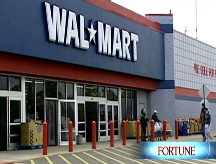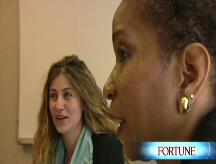The new new world order
Skyrocketing oil prices. Double-digit inflation. Is the great global economic boom finally coming to an end?

(Fortune Magazine) -- What may be the world's busiest grocery store is a Carrefour "hypermarket" in the Gubei area of Shanghai's Changning District.
Seven days a week, from 8:30 A.M. to 11 P.M., customers jam the aisles of this 126,000-square-foot market and fill their baskets with a dizzying array of produce, meats, and electronics from around the world. Last year six million people - more than twice the population of Chicago - shopped here and dropped $155 million along the way.
There are no signs of a global slowdown in these aisles. Carrefour's sales in China were up 25% in the first quarter of this year. Sales in places like Brazil and Romania jumped more than 50%. Poland is hot. So are Argentina, Turkey, and Colombia.
But the picture isn't the same in Carrefour's home country: France grew an anemic 2.6% last year. "If you're a consumer sitting in Paris and you're reading newspapers or watching TV, it looks like the world is coming to an end," says Carrefour executive David Shriver. "But consumers in places like China and Brazil simply don't see it that way."
Welcome to the new, precariously bipolar world.
While gross domestic product growth is cooling a bit in emerging markets, the results are still tremendous compared with the U.S. and much of Western Europe. The 54 developing markets surveyed by Global Insight will post a 6.7% jump in real GDP this year, down from 7.5% last year. The 31 developed countries will grow an estimated 1.6%.
The difference in growth rates represents the largest spread between developed and developing markets in the 37-year history of the survey. "The fact that the U.S. is no longer the locomotive of growth it was a few years ago," says Nariman Behravesh, Global Insight's chief economist, "doesn't seem to be that important anymore."
Put another way, the American consumer is still hungry, but the world consumer is voracious.
Consider the growing middle class in China, which is expected to multiply sevenfold by 2020, to 700 million people, according to Euromonitor, and India, where the number of middle-income folks will grow more than tenfold, to 583 million, says consultancy McKinsey & Co. First they want new homes with electricity - witness the quadrupling prices since 2000 of steel, oil, and copper. Then, as incomes rise, so does demand for everything from toothpaste to telephones, from automobiles to airplanes.
At first blush this sounds like great news for Global 500 companies: Chinese and Indian consumers essentially offsetting belt-tightening by Americans and Western Europeans. And indeed, overseas growth has been a bright spot - so far - for many of the world's largest corporations. Wal-Mart's (WMT, Fortune 500) international sales grew 17.5% this year - triple what it saw Stateside - and now constitute 24% of the company's total revenue, up from 8.9% a decade ago. Roughly half of GE's (GE, Fortune 500) gas turbines produced in Greenville, S.C., end up in Saudi Arabia, which is building four new cities; rival Abu Dhabi is spending $200 billion on attractions, including a Guggenheim museum.
"There is still a lot of double-digit growth out there," says John Rice, GE's vice chairman. "The clearly tougher financial markets in the U.S. don't appear to be impacting global demand for everything."
But double-digit growth is also creating double-digit inflation. Americans whine about $4 gasoline and $5 Cheerios, but elsewhere in the world the reaction is much more serious. Truckers in South Korea, France, and Spain have blocked highways to protest high fuel prices, and angry Egyptians barricaded roads after a cut in flour subsidies. In India inflation rose to above 8% in May from below 4% last August. Chinese inflation was 7.7% in May, up from 1% in early 2006.
It's worse in the smaller markets: Inflation now exceeds 30% in Ukraine and Venezuela and 25% in Vietnam. This translates into some pretty jaw-dropping price increases: Rents are up 82% in Dubai in 12 months, and rice prices in India have nearly tripled since January. Such rapid inflation can stifle growing economies, and many analysts think the great global boom eventually will flame out - or at least dramatically slow.
And let's not forget that many of the countries experiencing strong growth today depend on exports to the U.S. to keep their economies humming; a slowdown in U.S. spending surely will have ripple effects in places like India, China, Vietnam, and Mexico.
The problem is how to fix it. Most experts believe that to break the back of double-digit inflation, central bankers have to raise interest rates dramatically, which can result in higher fuel prices, rising unemployment, and eventually a recession.
"This kind of situation always ends in tears," says Global Insight's Behravesh. "If you let inflation get out of control, it hurts. If you try to clamp down, it hurts."
For the rest of the planet, a slowdown in the emerging world would be a double-edged sword: Once-hot markets for, say, L'Or�al lipstick or Tide detergent would cool, hurting corporate growth prospects. A less ravenous China or India, though, would surely lead to a drop in the price of many commodities, including oil, offering much-needed relief to pocketbooks worldwide.
What is the CEO of a Global 500 company to do? Listen to the doom-and-gloom economists and act cautiously, or keep pushing into fast-growing but fragile economies?
Smart executives are doing a bit of both, seeking new growth markets with the full understanding that their plans will be shaped and changed by global forces. Some of those trends are huge and long-lasting, like the rise of the global middle class. Others are not: Carrefour, for example, almost had a disaster on its hands when Chinese consumers threatened to boycott the chain over an event it could not foresee or control: A pro-Tibetan protester in Paris assaulted a wheelchair-bound Chinese Olympic torchbearer.
Robert McDonald, Procter & Gamble's (PG, Fortune 500) chief operating officer, has borrowed a military term to describe this new business world order: "It's a VUCA world," he says - volatile, uncertain, complex, and ambiguous. "The idea that a butterfly flaps its wings in Africa and an earthquake occurs somewhere else in the world is our reality. It's no longer just a nice book that Thomas Friedman wrote," he adds, referring to the New York Times columnist's book on globalization. "It's my life." ![]()
-
 The retail giant tops the Fortune 500 for the second year in a row. Who else made the list? More
The retail giant tops the Fortune 500 for the second year in a row. Who else made the list? More -
 This group of companies is all about social networking to connect with their customers. More
This group of companies is all about social networking to connect with their customers. More -
 The fight over the cholesterol medication is keeping a generic version from hitting the market. More
The fight over the cholesterol medication is keeping a generic version from hitting the market. More -
 Bin Laden may be dead, but the terrorist group he led doesn't need his money. More
Bin Laden may be dead, but the terrorist group he led doesn't need his money. More -
 U.S. real estate might be a mess, but in other parts of the world, home prices are jumping. More
U.S. real estate might be a mess, but in other parts of the world, home prices are jumping. More -
 Libya's output is a fraction of global production, but it's crucial to the nation's economy. More
Libya's output is a fraction of global production, but it's crucial to the nation's economy. More -
 Once rates start to rise, things could get ugly fast for our neighbors to the north. More
Once rates start to rise, things could get ugly fast for our neighbors to the north. More










